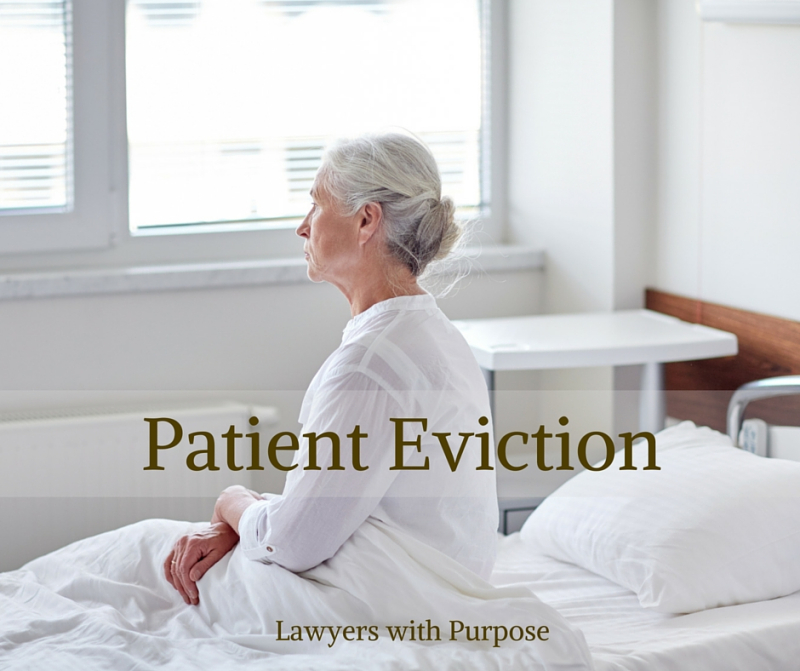Patient eviction is a growing problem in our country. Between 2000 and 2014, national Ombudsman programs report that eviction complaints are up 57 percent, despite the number of nursing home patients being slightly down. And the correlation between the growth of dementia and the eviction of patients seems clear. Knowing our state discharge procedures, appellate rights and care requirements is essential to us as elder care attorneys. Our understanding of patient rights and legal protections, along with a phone call to a facility, can often go further than anything a family can do.
How To Completely Understand The Rule Of Halves
Many Medicaid planning practitioners are aware of the rule of halves, but it is an area of confusion for many attorneys newer to the practice. Where does the rule of halves come from? Is it codified? Well, sort of. To understand the rule of halves you have to first understand the Medicaid law and then understand math.
 42 USC 1396p (c) (1) (e) provide a penalty period shall be imposed on any individual who transfers assets for less than its fair market value (uncompensated transfer). The law further states the penalty shall be calculated by taking the amount of the uncompensated transfer and dividing it by the average cost of one month's nursing home in the region in which the Medicaid applicant resides. That is all the law states, so the question becomes where does the rule of halves come from? That's where math comes in. In essence in light of the law identified, if you take any amount of money and divide it by two, the half you gave away will create a penalty period equal to what the half kept will pay.
42 USC 1396p (c) (1) (e) provide a penalty period shall be imposed on any individual who transfers assets for less than its fair market value (uncompensated transfer). The law further states the penalty shall be calculated by taking the amount of the uncompensated transfer and dividing it by the average cost of one month's nursing home in the region in which the Medicaid applicant resides. That is all the law states, so the question becomes where does the rule of halves come from? That's where math comes in. In essence in light of the law identified, if you take any amount of money and divide it by two, the half you gave away will create a penalty period equal to what the half kept will pay.
If an individual has $100,000.00 of excess assets, and gives half away, the $50,000.00 transfer will create a penalty period that will always equal the period the retained amount will pay thru. Assuming a regional divisor of $5,000.00, the penalty on the $50,000.00 transfer would be 10 months, and the $50,000.00 retained would thereby pay 10 months in a nursing home ($5,000.00). While the rule of halves, in its purest form, makes sense in practice, it's a little more complicated because one of the fallacies in using rule of halves, is it presumes that the regional divisor actually equals the cost of care (even by law it supposed to, it often doesn’t).
In the same example if you gave away $50,000.00 in a location the divisor is $5,000.00, it would create a 10-month penalty period, but, if the cost of care was actually $6,000.00, then the $50,000.00 retained would not pay through the 10-month penalty period (you would need $60,000). The federal Medicaid law requires the state to publish at least annually, the average cost of one‑month's private paid nursing home (regional divisor). Each state however, has their own way to calculate this and most facilities are above (rarely below) that regional rate. A few states (Illinois for example) have made the divisor the actual cost of care at the facility where care is being provided. That negates any concerns about the effectiveness of the rule of halves calculations.
Finally, when planning using the halves calculation, one must also consider the income of the Medicaid recipient. When a cost of care in excess of the divisor, creates in a shortfall of retained funds needed to pay through any penalty period, failing to take income into account, often creates excess resources for the client at the end of the penalty period, which will render them ineligible.
To illustrate, assume again an individual had $100,000.00 excess assets and transferred $50,000.00 with a monthly divisor was $5,000.00. The $50,000.00 transferred would create a 10-month penalty and the $50,000.00 retained would pay through the 10‑month penalty. All other things being the same, at the end of 10 months, with the recipient in a nursing home, they're not spending their monthly income (assume $1,200.00 Social Security) the client would have accumulated an additional $12,000.00 ($1,200.00 a month times 10 months) and have excess resources and therefore not be eligible for Medicaid until additional spend-down and penalty may be created.
Proper planning utilizing the rule of halves assumes an analysis of the actual cost of care, the actual regional divisor and the actual income of the recipient are considered. The LWP Medicaid Qualifying software automatically calculates the optimal client assets to transfer and retain considers the actual cost of care, the regional divisor and the clients actual income.
To learn more about Lawyers With Purpose and what we have to offer your estate or elder law practice, please join us THIS THURSDAY for our "Having The Time To Have It All… Three Time Strategies To Have A Practice With Profit And Purpose." Click the link for registration information and to reserve your spot now.
David J. Zumpano, CPA, Esq., Practicing Attorney, just like you & Founder of Estate Planning Law Center & Lawyers with Purpose LLC
How To Distinguish The Snapshot Date From The Look Back Date
Many lawyers doing Medicaid qualification for their clients often get confused between the snapshot date and lookback date. These dates are not only confused by lawyers, but also often by the Medicaid departments processing the application. So let's set it straight. 42 US 1396r-5 (c) states the snapshot date occurs on the first day of the month in which a Medicaid applicant reached thirty days of "continuous institutionalization". Continuous institutionalization is identified as thirty consecutive days in an institution of care. These include hospitals, nursing homes, VA facilities, or the like.
 If an individual enters a hospital on January 15, is discharged on January 30, enters a nursing home on February 5, and applies for Medicaid on March 1, no snapshot date has occurred. Why? It's simple. Thirty continuous days of institutionalization has not occurred by March 1. By virtue of the discharge from the hospital on January 30 and readmission to the nursing home on February 5, a lag occurred, restarting the 30 day period. Since they entered the nursing home February 5, and applied March 1, no snapshot date is set because thirty continuous days has not occurred.
If an individual enters a hospital on January 15, is discharged on January 30, enters a nursing home on February 5, and applies for Medicaid on March 1, no snapshot date has occurred. Why? It's simple. Thirty continuous days of institutionalization has not occurred by March 1. By virtue of the discharge from the hospital on January 30 and readmission to the nursing home on February 5, a lag occurred, restarting the 30 day period. Since they entered the nursing home February 5, and applied March 1, no snapshot date is set because thirty continuous days has not occurred.
Continuing, if the client stays in the nursing home through March 5, then the snapshot date would be February 1, the first day of the month in which the applicant entered a facility for thirty days of continuous institutionalization. The significance of the snapshot date is it represents the date Medicaid will look at all financial assets owned by the Medicaid applicant and spouse in determining whether or not they are eligible for benefits. In this case, Medicaid would take a "snapshot" of all assets owned by the applicant and spouse on February 1 and use this information to determine the client's individual resource allowance, the community spouse resource allowance, and the client's net available monthly income that can be used for the cost of care.
What makes all this confusing is, although the federal statute is clear as outlined above, most states treat the “lookback date”, as the "snapshot date." The lookback date is entirely different; it is the date when applicant resides in a nursing home AND applies for Medicaid benefits. In this case the lookback date does not occur until the Medicaid applicant applies for Medicaid. Since they are already in the nursing home, they would have to apply for benefits to establish the lookback date.
In this case, if an application was filed, the lookback date would also be March 1, the first day of the month of application after admission. In many cases clients come to you long after the snapshot date and in many cases may have been residing in a nursing home for many, many months, before they apply for Medicaid so no lookback has been established. The lookback date has a use and different significance than the snapshot date. While the snapshot is used to calculate all the allowable exemptions, the lookback date is used to establish the date at which Medicaid will look back sixty months at all financial data of an applicant to determine if there were any uncompensated transfers.
Understanding these key definitions is critical in having an effective Medicaid practice, but more importantly, to get your clients confident they will be eligible in the timeframe you identify. To learn more about Asset Protection and Medicaid Planning for your estate or elder law practice, consider joining us next week in Charlotte, NC, for our Practice With Purpose Program. We'll be covering this and so much more just on Day 1! We'll also be allowing a test drive in the room to review our drafting software!
David J. Zumpano, Esq, CPA, Co-founder Lawyers With Purpose, Founder and Senior Partner of Estate Planning Law Center
Medicaid Planning For Previously Transferred Assets
Many clients who come into my office in search of "qualifying for Medicaid" are concerned about losing their assets. Unfortunately, in many instances they got advice at the beauty shop or coffee shop (and sometimes a lawyer) to give their assets away so that they could be protected if sixty months goes by.
 As we know, there is no rule that says a client has to wait 60 months, even if they transferred assets, and we are typically able to get clients qualified in much shorter periods of time, even in crisis. When preplanning, we are also able to protect between fifty and one hundred percent of assets immediately with the proper facts and planning. Understanding this level of planning requires a complete and thorough understanding of the 12 key Medicaid rules and how they apply to each client differently. For a demonstration of how the LWP industry exclusive software documents tally in minutes for any client fact pattern go to https://www.lawyerswithpurpose.com/Estate-Planning-Drafting-Software.php to schedule a software demo.
As we know, there is no rule that says a client has to wait 60 months, even if they transferred assets, and we are typically able to get clients qualified in much shorter periods of time, even in crisis. When preplanning, we are also able to protect between fifty and one hundred percent of assets immediately with the proper facts and planning. Understanding this level of planning requires a complete and thorough understanding of the 12 key Medicaid rules and how they apply to each client differently. For a demonstration of how the LWP industry exclusive software documents tally in minutes for any client fact pattern go to https://www.lawyerswithpurpose.com/Estate-Planning-Drafting-Software.php to schedule a software demo.
A key challenge for many clients who have already transferred assets is, how does it figure in in determining their eligibility now, in crisis, or later if they are preplanning. (The answer comes down to two distinctions.)
First, has the transfer been within the sixty months of when they come to see you? If so, the amount of the transfer should be added back to the client's assets as if they still owned them. That is the practical result when applying for Medicaid if within the sixty months of the application. Re-including the assets provides a proper picture of all assets of clients that have to be considered in determining how much can be protected and how much would be lost if the client is in crisis or will require long-term care within sixty months of the transfer.
After re-including the transferred assets, you must then calculate the amount of assets that will be protected and those that will be needed for care (in a crisis case), or, could be needed in a preplanning case, (if care is within sixty months). The key distinction actually comes down to funding. Pre‑transferred assets are a funding issue, not a calculation issue. After adding back the transferred assets and completing the calculations to determine the amount protected, then the first funding task is to allocate the previous transfer to the amount protected and then you only have to fund the balance. If the previous transfers are more than the amount of assets that could be protected, the family must make up for the excess transfer by giving it back (cure). If the amount previously transferred is less than the amount protected then the balance of the assets that can be protected, are thereafter transferred pursuant to the asset protection plan created by the attorney.
While complicated in the written word, with a proper understanding of the law and how to apply it to each client and when you have the software that calculates and supports the law and provides calculations in real time utilizing the Medicaid laws, you are able to confidently help your client protect their assets.
If you are interested in learning more about becoming a Lawyers With Purpose member, consider joining us for our Practice With Purpose Program in Charlotte, NC, February 3rd – 5th. We are almost at capacity and there are only a few seats left so register today!
David J. Zumpano, Esq, CPA, Co-founder Lawyers With Purpose, Founder and Senior Partner of Estate Planning Law Center
When It Comes To Medicaid, What Is The Break-even Point
The break-even point is the point at which it doesn’t matter whether the individual applies for Medicaid or continues to private pay. Either way, the individual is going to pay the same amount.
 Let’s say that the minimum months to qualify is 20 months. The break-even point is 40 months. (60 minus 20). If at any time the individual goes into the nursing home and applies for Medicaid prior to 40 months, you will “flip the switch” and apply for Medicaid. The penalty period is 20 months, so the individual private will have to private pay for those 20 months. If that was done in month 10, then the individual will pay the penalty until the 30th month from the date of the funding of the iPug. (10 months plus 20 months penalty = 30 months from funding). The individual will begin to receive Medicaid benefits the 31st month. The individual does not have to wait until month 60 from the date of the funding to get their benefits in that scenario.
Let’s say that the minimum months to qualify is 20 months. The break-even point is 40 months. (60 minus 20). If at any time the individual goes into the nursing home and applies for Medicaid prior to 40 months, you will “flip the switch” and apply for Medicaid. The penalty period is 20 months, so the individual private will have to private pay for those 20 months. If that was done in month 10, then the individual will pay the penalty until the 30th month from the date of the funding of the iPug. (10 months plus 20 months penalty = 30 months from funding). The individual will begin to receive Medicaid benefits the 31st month. The individual does not have to wait until month 60 from the date of the funding to get their benefits in that scenario.
If the individual applies for Medicaid on the break-even point – month 40, they will still have a 20 month penalty, which will push them to 60 months from the funding date. If they don’t apply for Medicaid in month 40, then the individual would have to private pay for those 20 months until month 60. After which time, the individual will apply for Medicaid and Medicaid won’t see the transfer 61 months earlier. Either way it costs the same; it doesn’t matter whether you apply for Medicaid or not. (That said, know your local rules too – in Texas for example, there is a slight benefit for being on Medicaid and in the penalty period, so I would probably go ahead and apply at the break-even point for Texas residence).
Now, if the individual becomes ill in month 45 and goes to the nursing home and applies for Medicaid, then applying for Medicaid still triggers the 20 month penalty. This will push the Medicaid eligibility out past the 60 months to month 65 (45 months from funding plus 20 months of penalty). This is beyond the initial 60 months from funding, so you don’t want to apply for Medicaid after the break-even point. If the individual makes it past the break-even point before they need a nursing home, they will private pay the nursing home cost until month 60. After month 60 passes, the individual can apply for Medicaid and answer “no” to the question of have you given any money away in the last 60 months and avoid the 20 month penalty.
David J. Zumpano, Esq, CPA, Co-founder Lawyers With Purpose, Founder and Senior Partner of Estate Planning Law Center
Medicaid Planning: The Ins & Outs of MMMNA #5 – Asset Tests
This post continues our Medicaid planning series with a deep dive into MMMNA, or the minimum monthly maintenance needs allowance, which is the minimum income allowance for the community (or well) spouse in a Medicaid claim. We've already covered some of the basics of determining MMMNA for your clients; If you didn't see the previous posts, click on the links to find numbers One, Two, Three and Four.
 So, similar to the rules we covered on the individual income allowances, there’s also the asset test. Unlike the income allowances where you’re allowed $60 a month or $80 a month, under the asset test you’re allowed a certain amount of assets. The minimum is $1,500; by federal law they cannot allow you less than $1,500 of assets per month. About 80% of the states go beyond that, allowing $2,000 per month. And in a few states it's even higher. One day New York sent out a notice saying the state was increasing the individual resource allowance to $14,400, which was a windfall for our clients. There are also some states at $5,000 or other amounts, and about a dozen other states are at the $1,500 minimum.
So, similar to the rules we covered on the individual income allowances, there’s also the asset test. Unlike the income allowances where you’re allowed $60 a month or $80 a month, under the asset test you’re allowed a certain amount of assets. The minimum is $1,500; by federal law they cannot allow you less than $1,500 of assets per month. About 80% of the states go beyond that, allowing $2,000 per month. And in a few states it's even higher. One day New York sent out a notice saying the state was increasing the individual resource allowance to $14,400, which was a windfall for our clients. There are also some states at $5,000 or other amounts, and about a dozen other states are at the $1,500 minimum.
When you see a state that has a $1,500 resource allowance, then you know it's a 239B state. What does that mean? Back in the '70s there was a code section 239B that raised the allowance from $1,500 to $2,000 federally. But some states complained, so under 239B of the statute they allowed the states to opt out of the increase. Remember, federal Medicaid laws allow the states to be less restrictive but not more restrictive. So you would think if a state allows a $1,500 resource allowance when the federal minimum is $2,000, such a state would run afoul of that standard. And you would be correct, unless that state filed an election under section 239B to maintain the $1,500 minimum resource allowance. So if your state’s minimum resource allowance is $1,500, you are a 239B state. It's a term worth knowing because you might hear it at CLEs and events of that nature.
So what about the community spouse? We know the individual can only have $1,500 to $14,400, depending on which state you’re in. The federal government addressed the community spouse question with the 1988 Medicare Catastrophic Coverage Act. The MCCA, attempting to avoid impoverishing community spouses, set a new federal minimum amount that a community spouse has to be allowed to keep. And what is that amount? Much like the federal government did with income limits, it set a minimum maximum and a maximum maximum. And for some reason, the minimum changes every July and the maximum changes every January. Last July the minimum was raised to $23,184, so the states cannot allow a community spouse less than that. If you’re in a max state, then your state will now allow the community spouse $115,920.
And again, similar to the income exercise, if the community spouse’s assets are more than the minimum but less than the maximum, then the community spouse resource allowance (CSRA) will be the amount of the community spouse’s assets. So, for example, if I were to say that a husband had $200,000 of assets and a wife had $10,000 of assets, we would first determine who went into the nursing home. If the husband went into the nursing home, the wife only has $10,000, so she would be able to take $13,184 of the husband’s excess assets and then the rest would have to be used toward his cost of care. If the wife went into the nursing home with her $10,000 of assets and the husband had $200,000, the most that the community spouse could have is $115,920, so the difference between the $115,920 and $200,000 would have to go toward the cost of care.
There are exceptions. We can keep some assets by utilizing some special exemptions. But generally speaking, the rule is very simple. The institutionalized spouse is allowed to have $1,500 to $14,400; the community spouse is allowed a minimum of $23,184 or a maximum of $115,920 if you’re in a range state, and if you’re in a max state the allowance is $115,920.
So now that you've seen how to calculate the CSRA, let's try a few examples. If a couple has $130,000 of total countable assets between the husband and wife at the snap shot date, then how much would the CSRA be? The couple lives in Connecticut, which is a range state. In a range state, how much would the community spouse be allowed to keep? Well, we know that half of $130,000 is $65,000. And according to range state rules, if x is greater than the max, then the CSRA equals the max. If x is less than the minimum, then the CSRA equals the minimum or the assets. If x is greater than the minimum but less than the max, then the CSRA equals x. So in this case, that’s what we would have. Connecticut’s a range state. And because $65,000 is below the maximum of $115,920 but above the minimum of $23,000, then the CSRA in Connecticut would be $65,000.
Now try another example: We’re in Florida, which is a max state. So even though half of the countable assets are $65,000, the CSRA cannot be less than $115,920 in a max state, so that is what the CSRA would be in this example.
How about a case in Kansas where one half of the countable assets come to $8,500? If you're asking yourself whether Kansas is a max state or a range state, well, it really doesn’t matter for this example, does it? The CSRA minimum is $23,184, so the CSRA cannot be more than the amount of assets they have. So in Kansas, which is a range state, the whole $17,000 would be exempt, but the additional $6,184 would also be exempt if that client came into additional assets.
And finally, if I’m in Arizona, which is a max state, I can never have more than the $115,920. So if the couple has $250,000, then half of that still exceeds the max. I can never have less than the minimum or greater than the max. If you’re in the middle, you get the range amount, and in this case you can keep $115,920, because there’s a total of $130,000 assets.
Hopefully these examples help you understand how this works. We will wrap up our MMMNA series with a post on snap shot dates, so check back soon.
Medicaid Planning: The Ins & Outs of MMMNA #4 – Income Cap States
Thanks for coming back for more about MMMNA, or the minimum monthly maintenance needs allowance, which is the minimum income allowance for the community (or well) spouse in a Medicaid claim. We've already covered some of the basics of determining MMMNA for your clients; If you didn't see the previous posts, click on the links to find numbers One, Two and Three.
 One question you might have to deal with in MMMNA calculations is the income cap, if you're in a state that has one. Income cap states are a little bit of a different animal, and they raise a question: Does the insurance allowance include the Medigap premium? Yes it does. So Medicaid will allow you to deduct any cost of insurance and Medicare will be a primary insurer, which means they’re going to allow you any insurance costs related to the Medigap because that benefits Medicaid. In other words, Medicare would be the primary payer, and Medicaid would become the secondary.
One question you might have to deal with in MMMNA calculations is the income cap, if you're in a state that has one. Income cap states are a little bit of a different animal, and they raise a question: Does the insurance allowance include the Medigap premium? Yes it does. So Medicaid will allow you to deduct any cost of insurance and Medicare will be a primary insurer, which means they’re going to allow you any insurance costs related to the Medigap because that benefits Medicaid. In other words, Medicare would be the primary payer, and Medicaid would become the secondary.
Another issue along these lines is income limits. The income limit applies to the institutional spouse only in an income cap state.To review, in our previous posts we talked about the MMMNA individual allowance and the personal needs allowance, and we went over the MMMNA for a person who is married. The income cap is a different provision. In income cap states, it doesn’t matter if you’re married or single. It doesn’t matter what your income allowances are. It’s just a simple test: If a Medicaid applicant’s income exceeds $2,130, then the applicant doesn’t qualify for Medicaid. According to income cap states, that person has too much money.
It doesn’t matter how much the spouse’s income is. This is an income limit on the applicant only. So in the case we had before where the husband made $3,000, he would be over the income cap and therefore would not qualify. It might sounds ridiculous and you might feel bad for people who are in an income cap state, but that's the bottom line.
So our usual approach in such states is to do a Miller trust, which is a qualified income trust, or QIT. In a Miller trust, the husband assigns his income to the trust and then the trust pays the cost of care. It’s kind of silly to have to take that step, but those of you who are in income cap states are probably pretty familiar with the Miller trust, so it's not a big issue. If you’re not in an income cap state, you won't have to worry about it.
That's about all we can cover in today's post. Check back back soon for a discussion on MMMNA asset tests.
To learn more about Medicaid join us at our Practice With Purpose event in June. You'll experiece 2.5 days of all that you need training about Asset Protection, Medicaid and VA.
David J. Zumpano, Esq, CPA, Co-founder Lawyers With Purpose, Founder and Senior Partner of Estate Planning Law Center
Medicaid Planning: The Ins & Outs of MMMNA – Part 3
Income Allowance:
Thanks for coming back for another session of MMMNA school. There's a lot to this issue, and it can get a bit complex, but it's an important component in Medicaid planning.
This post is part three of our series on determining MMMNA, the minimum monthly maintenance needs allowance, which is the minimum income allowance for the community (or well) spouse in a Medicaid claim. If you didn't see the first post, you can find that here, and part two is here.
 Our last post got into a few scenarios involving MMMNA, but there are some additional income allowances that we need to cover. The institutionalized spouse is allowed a personal needs allowance, which as we said, ranges from $30 to $106.50, depending on the state. The applicant is also given allowance to help pay for health insurance. So Medicaid basically says, we don’t want to get stuck being the primary insurance payer, so in addition to your personal needs allowance, we’re going to allow you enough money to pay your health insurance premium so your insurance company can be the insurance of first resort and Medicaid can be your backup.
Our last post got into a few scenarios involving MMMNA, but there are some additional income allowances that we need to cover. The institutionalized spouse is allowed a personal needs allowance, which as we said, ranges from $30 to $106.50, depending on the state. The applicant is also given allowance to help pay for health insurance. So Medicaid basically says, we don’t want to get stuck being the primary insurance payer, so in addition to your personal needs allowance, we’re going to allow you enough money to pay your health insurance premium so your insurance company can be the insurance of first resort and Medicaid can be your backup.
To be clear, Medicaid only exempts the cost of health insurance for the institutionalized spouse, not the community spouse. So, only the institutionalized spouse gets the personal needs allowance and the health insurance allowance. The community spouse gets the MMMNA, which we’ve already talked about. In addition, about 25% of the states also have a housing and shelter allowance, and another 25% of the states have a heating and utility allowance. These allowances are a state specific issue. The federal law does permit it, but not all the states do it. And again, it's for the community spouses only, with the intent being to make sure that community spouses have sufficient income to stay in their homes.
So again, institutionalized spouses gets their personal needs allowance of somewhere between $30 and $106.50 and they get to keep the cost of their health insurance so they can continue to pay that. Medicaid will let them do that. And the community spouse gets the MMMNA that we reviewed previously. Also, the community spouse could get a housing and shelter allowance or a heat and utility allowance if the state permits it. That's it, period. If you’ve got that down, that’s all you’ve got to know; it’s never going to change. If you're confused, it's because you’re trying to make it do something else, but it's really that simple. You just have to apply the rule.
So, no matter what fact pattern is that you are looking at, the first thing you need to determine is whether you are looking at a max state or a range state, then follow the methodology we shared in the previous two posts. Next look at the income of the husband, then look at the income of the wife. Figure out which spouse is in the nursing home, and which spouse is in the community. Then you can calculate the MMMNA. And in addition to the MMMNA, you will possibly have the housing and shelter allowance and the heating utility allowance, depending on the state. Of course, if the applicant is not married, you don’t even have to worry about that MMMNA calculation. All of the income that a single applicant gets to keep is the personal needs allowance and the health insurance premium amount.
You are probably thinking, OK, that's not so tough. And you're right, but you're not through it yet. Our next post will cover the income cap rules that factor in, so check back soon for that.
Medicaid Planning: The Ins & Outs of MMMNA – Part One
Part of planning for a married Medicaid applicant is figuring the minimum monthly maintenance needs allowance, which is the minimum income allowance for the community (or well) spouse. Medicaid law says that the income of the Medicaid applicant in excess of the limits must be used toward the cost of care. But if the applicant has a spouse, Medicaid, through the concept of the minimum monthly maintenance needs allowance (“MMMNA”), allows the community spouse to keep some or all of their income.
 Medicaid considers the gross income of the community spouse. If the community spouse’s income is in excess of the MMMNA, then under the federal rules, 25% of the community spouse’s income must be used for cost of care. While New York is currently the only state that enforces that provision, we must be aware of the federal rules because it is probably only a matter of time before other states are assessing the 25%.
Medicaid considers the gross income of the community spouse. If the community spouse’s income is in excess of the MMMNA, then under the federal rules, 25% of the community spouse’s income must be used for cost of care. While New York is currently the only state that enforces that provision, we must be aware of the federal rules because it is probably only a matter of time before other states are assessing the 25%.
Now if the community spouse’s income is less than the MMMNA, then income from the applicant will be diverted to the community spouse to try to get the community spouse’s income up to the MMMNA. If the community spouse’s income is still below the MMMNA, then assets needed to generate sufficient interest to fill the income up to the MMMNA are exempt. This is what we call the assets to income rule.
But there's a little more to it than that. The federal law says there’s a minimum and there’s a maximum MMMNA. The states are allowed to set the MMMNA for the community spouse. But the federal government says the states can’t set a MMMNA below $1938.75 (we will call it $1,939 to keep the math easy) or above $2,931. So your state’s MMMNA will be somewhere between those two numbers.
States vary in how they set the MMMNA. About half of the states are what we call “max states.” They set the MMMNA at the maximum end of the range and say that the community spouse can keep up to $2,931 in gross monthly income. Other states are “range states.” That is the MMMNA can fall somewhere between both the maximum and minimum range the feds allow for the MMMNA. In a range state, if the community spouse's income is less than $1,939, then the community spouse can take the institutionalized spouse’s income up to that minimum. And what happens if the community spouse’s income was more than the minimum but less than the maximum? Then the income of the community spouse would be the MMMNA.
Let’s consider the following examples to show you what I mean.
I had a community spouse who had $1,000 of income. The applicant, the husband, was the predominant income earner, and the community spouse had $1,000 of income. In a max state, the law says the community spouse could keep the first $2,931, regardless of whom it came from. So if the wife had $1,000 of income, she would be able to keep the first $1,931 of the income of the husband, who’s in the nursing home. And if the husband didn’t have $1,931, then the assets to income rule would come into play. That means the law would say that, if the total income between the institutionalized spouse and the community spouse does not equal the MMMNA, then the community spouse can exempt additional assets needed to generate the income to get the community spouse up to the MMMNA. So again, if this is a max state, the threshold is $2,931. If the community spouse had $1,000 and the husband had $3,000 of income, the community spouse would be able to keep $1,931 of the applicant’s income.
In a range state, the community spouse is allowed to keep the minimum, but if the income is below $1,939, then the community spouse gets to take income from the institutionalized spouse to get to the $1,939 limit. For instance, if a community spouse’s income was $1,000, she could take $939 from the husband’s income. If she had income of $2,500, then her MMMNA would be $2,500 because her income is below the maximum and above the minimum MMMNA. And if a community spouse earns more than the maximum MMMNA, then 25% of that amount in excess would have to be contributed toward the cost of care. Those are the federal rules. But remember, as of now only New York applies the 25% rule. Most states allow the community spouse to keep any income in excess of the MMMNA.
We will continue to delve into MMMNA in future posts on this blog, to help you understand the nuances and work through the complexities of this issue.
David J. Zumpano, Esq, CPA, Co-founder Lawyers With Purpose, Founder and Senior Partner of Estate Planning Law Center
Medicaid: Understanding The Six Activities of Daily Living Standards (ADL’s)
Many times in complicated Medicaid planning cases, the attorney is trying to work out the funding plan before figuring out what rules apply. Before you go any further, you've got to determine whether the client is eligible, and what the qualification standards are.
Everyone focuses on the assets and income test, but that's not the only test. Number one is, does the client meet the needs test? By that we mean the “Activities of Daily Living,” or ADL's. They are necessary in determining eligibility for Medicaid.
 The six ADL standards for Medicaid clients are whether they can:
The six ADL standards for Medicaid clients are whether they can:
- Bathe themselves.
- Dress themselves.
- Transfer from a bed or chair, which usually means from a sitting position to a standing position.
- Walk.
- Feed themselves.
- Toilet themselves.
If your client is unable to do one of those six things, the client would be considered in need of adult care, which is the lowest level of care. If the client is missing two of the six, that would earn a rating of assisted living. If the client needs help in three or more of those areas, that would be considered chronic care need or nursing home need, which in most states is the threshold that qualifies the client for Medicaid.
There is a major exception to the ADL standards, however: severe dementia. Usually severe dementia will inhibit the client's ability to do one or two of the six ADLs, but not always. If you can bathe and dress yourself – and you can do all six of these things, but you don't know why you’re doing it or how to do it or when to do it, then you will be considered to have severe dementia, which is an automatic qualifier for chronic care or nursing home care.
One other note: Traditionally, Medicaid only covers the chronic care level. Some states, including New York, will cover assisted living, but those rules are dependent on your state. Most states do not cover assisted living. So knowing your state's standard is essential to serve your Medicaid clients.
David J. Zumpano, Esq, CPA, Co-founder Lawyers With Purpose, Founder of MPS, Founder and Senior Partner of Estate Planning Law Center







